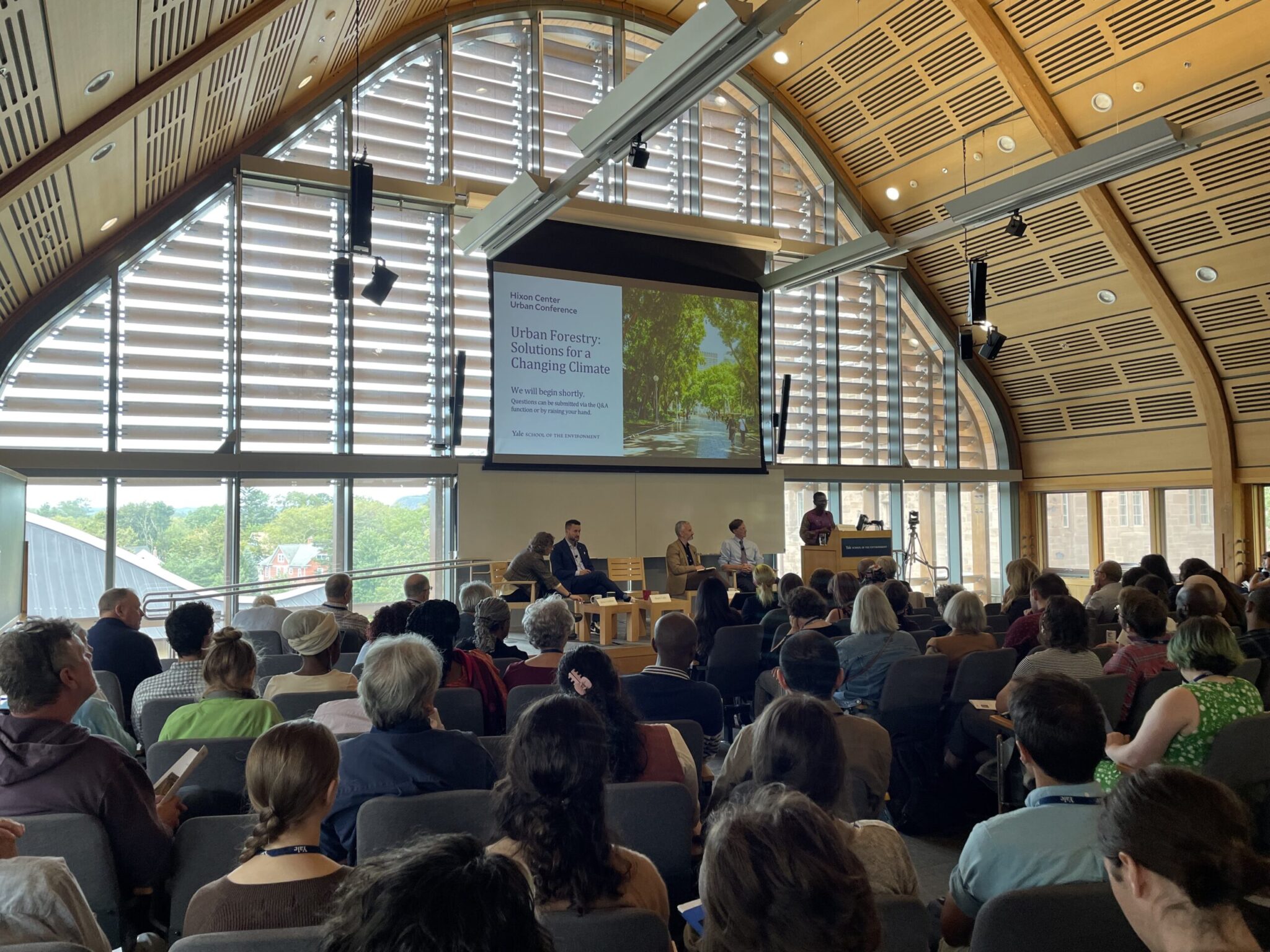Hixon Conference talks urban forestry
The Yale School of the Environment’s 10th annual Hixon Urban Conference explored the centrality of urban forests in mitigating climate change and offering remedies for global warming.

Hanwen Zhang, Staff Photographer
The School of the Environment opened its doors to the New Haven community for a full day of panel discussions with sustainability experts from around the world as part of its 10th annual Hixon Urban Conference last Friday.
This year’s conference focused on the potential of urban forests — trees growing in cities — as a climate solution. The conference also shared breakthroughs in local tree-planting efforts and explored new forest management strategies. Notable speakers included Beattra Wilson, forest service assistant director at the U.S. Department of Agriculture and New Haven Mayor Justin Elicker.
“Just generally, I think coming to a conference like this is super helpful,” Jack Hatajik ENV ’25, a first-year graduate student at the School of the Environment, told the News. “Being able to hear perspectives from outside of this YSE bubble is very, very helpful in … my goals for my research and what I hope to do in the future.”
One of the conference’s central themes highlighted how caring for trees should mean more than just planting them. In her keynote address, Wilson reflected on her team’s work in increasing the federal urban forestry budget to $1.13 billion this year — up from $32 million last year — and looked ahead to the challenges of advancing equitable access to nature.
Wilson stressed the importance of encouraging tree planting efforts, engaging youth and grassroots efforts, soliciting community feedback and educating the public about environmental issues. The blueprint for building America’s urban forests, Wilson said, starts with empowering the next generation to care for the environment and “[making] sure that we reflect urban America.”
One of the conference’s panels brought together mayors from cities around the globe, placing Wilson’s advice under a locally-focused lens. Yvonne Aki-Sawyerr, mayor of Freetown, the capital of Sierra Leone, spotlighted the city’s ambitious forestry efforts even in the face of the urban planning crisis, which Aki-Sawyerr explained stems from Sierra Leone’s civil war and an influx of climate refugees.
By engaging with community-based growers, her administration has planted over 850,000 trees and is soon set to surpass the one million mark.
Matus Vallo, mayor of Bratislava, Slovakia, echoed Aki-Sawyerr’s remarks by acknowledging that local community members “need to be a part of the equation.” Though unanimous consent is rarely possible to achieve, Vallo said that citizens should play a crucial role in the process — even if convincing them is difficult at first.
Elicker laid out his vision for a more sustainable New Haven, explaining the city’s plans to achieve “net climate-zero impact” by 2030. He cited New Haven’s recent pilot initiatives to purchase electric garbage trucks and police cars as part of the plan. Elicker also offered a preview of upcoming bus and bike lane construction as part of an effort to create a city that is “more walkable, more humane, more densely populated.”
“I’m fascinated to hear about all the work people are doing in different contexts,” panel speaker Sharon Danks told the News. Danks’s decades of work as founder and CEO of Green Schoolyards of America have focused on protecting children from extreme heat by bringing trees to schoolyards. “We need to be looking out for people who are vulnerable — elderly and young children in particular, and places where communities are not as resilient,” she explained.
In the conference’s second panel, park managers and researchers spoke about responsible urban forest preservation. Forest Park Ecologist Amy Witt detailed some of the park’s recent approaches to integrating silvicultural practices into the heart of St. Louis. Though Witt said she has seen public support for forest management slowly increase in recent years, she explained that park managers still need to find common ground with the community.
Contrary to popular thought, Witt noted, sustainably managing forests may sometimes require removing a handful of trees. Planned disturbances — such as mowing, prescribed burns and thinning — help mimic natural wildfire and grazing practices, keeping invasives at bay and clearing enough space for saplings to grow, according to Witt. She explained that absent proper forest management, forest growth can be stunted by unwanted pests or a scarcity of sunlight. Invasives are currently “the number one cause of ecological challenge” according to panelist Clara Pregitzer GRD ’20, deputy director of conservation science at the Natural Areas Conservancy.
USDA research ecologist Richard Hallett shared recent efforts to understand the effect of climate change on oak tree survival. Coordinating with rural and urban arborists across the eastern half of the United States, he created a silviculture network that collected 100,000 acorns from a range of locations spanning Tennessee to Massachusetts. The network has planted 9,000 of the across four cities and three arboretums who will monitor how the transported oaks respond to the differences in local climate.
“I’m very appreciative of Yale for having the conference,” said Steven Cronkite, a member of the Middletown Urban Forestry Commission, who noted that he had come to learn about the impacts of climate change on our forests.
During the conference, Karen Seto, director of the Hixon Center, also announced that the Hixon Center of Urban Ecology will be renamed to the Hixon Center of Urban Sustainability. According to Seto, the name change will better emphasize the center’s efforts of “bridging science with practice.”
For community member Susan Yang, the conference was an eye-opening experience that showed her different climate efforts she had not been aware of.
“People are doing more efforts than I realized to address climate change, and it makes me feel more positive,” Yang noted.
The Hixon Center was established in 1998 by donations from Alec Hixon ’38 and Adelaide Hixon.







